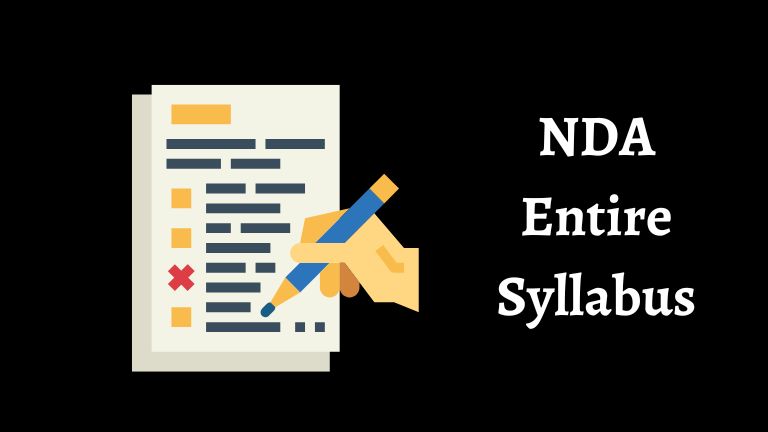NDA stands for The National Defense Academy, they made NDA Syllabus. NDA Syllabus is the Joint Services academy of the Indian Armed Forces.. The Union Public Service Commission (UPSC) conducts the National Defence Academy (NDA) Exam every year.
NDA is a national-level exam conducted twice a year, one of India’s most sought-after defense jobs. Male candidates can join the Defence Forces as an officer. Will make the selection of eligible males & females into NDA based on the written test followed by the Personality Test.
NDA Syllabus 2022
NDA is a written examination. There are mainly two papers, such as Mathematics and General Ability Test (GAT). Candidates who are thinking of applying for the NDA examination 2020. Now, you start preparing for these. First, 1 st Exam of the NDA will be conducted offline on 10th April 2022. The second exam date is for NDA and will be on 04th September 2022. As per the UPSC Calendar 2022. The detailed syllabus is below. Let’s see
NDA Syllabus: Overview
Before going to give the exam, you have to look out for the syllabus and exam pattern. Hence, you canCheck the important points of the NDA 2022 Syllabus. So, the points are below
| Name of the Exam | National Defence Academy (NDA) |
| Conducting Body | Union Public Service Commission, UPSC. |
| Frequency Of Exam | Twice in a Year (April & September 2022) |
| Selection Process |
|
| Mode of exam | Offline |
| Papers in NDA Exam |
|
| Marks Segregation |
|
| Total No. of Questions |
|
| Negative Marking |
|
| Exam Duration | 2.5 Hours For Each Paper (5 hours total) |
| Language of Question Paper | English & Hindi English Language paper has to be attempted in English. |
NDA Exam Pattern 2022
Before we get into the NDA Syllabus, let’s look at the NDA Exam Pattern. The mathematics paper has 120 questions with 300 marks. And GAT will have English and GK Papers of 200 & 400 prints. Respectively.
NDA Mathematics Exam Pattern for Paper I
| Total Marks | 300 Marks |
| Total No. of Questions | 120 |
| Marks awarded for Correct answer | 2.5 marks |
| Marks deducted for the wrong answer | -0.83 |
| Exam Duration | 2.5 Hours |
Paper II – General Ability Test
| Total Marks | 600 marks |
| Total No. of Questions | 150 |
| No. of questions in the English Section | 50 |
| No. of questions in General knowledge Section | 100 |
| Maximum Marks for English | 200 marks |
| Maximum Marks for G.K. | 400 marks |
| Marks for Correct Answer | 4 marks in both sections |
| Marks for Incorrect Answer | -1.33 marks in both sections |
| Exam Duration | 2.5 Hours |
NDA Syllabus Exam Pattern for SSB Interview
After clearing the written exam NDA, candidates have to appear for the SSB Interview rounds. The pattern of NDA interviews is as mentioned below:
| Stage 1 | Screening Test |
|
| Stage 2 | Psychological Test |
|
| Group Testing Officers Test |
|
|
| Personal Interview & conference | —– |
NDA Syllabus 2022
After that, getting to know the NDA Exam Pattern, the candidates need to know the Syllabus of the NDA Exam. NDA Syllabus is below
NDA Mathematics Syllabus
The chapter-wise topics covered for NDA Math Syllabus are table below.
Algebra
There are many topics on algebra. lets see
- Sets
- Venn diagrams
- De Morgan laws
- Cartesian product
- relation
- Equivalence relationship
- Real numbers
- Complex numbers
- Modulus,
- Cube roots
- Conversion of a number in Binary system to Decimals and vice-versa.
- Arithmetic
- Geometric and Harmonic progressions.
- Quadratic equations
- Linear inequations,
- Permutation and Combination
- Binomial theorem
- Logarithms.
Calculus
- Concept of a real-valued function
- domain
- range,
- Also, graphs of the function.
- Composite functions
- one-to-one, onto, and inverse functions.
- The notion of limit
- Standard limits
- Continuity of functions
- Algebraic operations on continuous functions.
- Derivatives of function at some point
- geometrical and physical interpretation of a derivative-application.
- Derivatives of sum, product, and quotient of functions
- Derivative of a function concerning another function
- Derivative of a composite function.
- Second-order derivatives.
- Increasing and decreasing functions.
- Application of derivatives in problems of maxima and minima
Matrices and Determinants
- Types of matrices
- operations in matrices.
- Determinant of the matrix
- Basic Properties of Determinants.
- Adjoint and inverse of a square matrix
- Applications-Solution of a system of linear equations in two or three unknowns by Cramer’s rule and by Matrix Method.
Integral Calculus and Differential Equations
- Integration as inverse of differentiation
- integration by substitution and by parts
- standard integrals involving algebraic expressions
- trigonometric
- exponential
- and hyperbolic functions.
- Evaluation of definite integrals—determination of areas of plane regions bounded by curves—applications.
- Definition of order and degree of a differential equation
- and formation of a differential equation by example.
- General and particular solutions for differential equations
- solution of the first order, and first-degree differential equations of various types—examples.
- Application of problems of growth and decay.
Trigonometry
- Angles and their measures in degrees and radians.
- Trigonometric ratios.
- Trigonometric identity sum and difference formulae.
- Multiple and sub-multiple angles.
- inverse trigonometric functions.
- Applications-Height and distance
- properties of triangles.
Vector Algebra
- Vectors in two to three dimensions
- magnitude
- and direction of the vector.
- Units and null vectors
- the addition of vectors
- scalar multiplication of a vector
- scalar product or dot product of two vectors.
- Vector product or cross product of two vectors.
- Applications—work done by force and moment of a force and in geometrical problems.
Analytical Geometry Of Two and Three Dimensions
- Rectangular Cartesian Coordinate system.
- Distance formula.
- Equation of a line in various forms.
- The angle between the two lines.
- Distance of a point from a line.
- Equation of a circle in standard and a general form.
- Standard forms of parabola, ellipse, and hyperbola.
- Eccentricity and axis of a conic. Points in a three-dimensional space
- the distance between the two points.
- Direction Cosines and direction ratios.
- Equation of two points.
- Direction Cosines and direction ratios.
- Equation of a plane and a line in various forms.
- The angle between two lines and the angle between two planes.
- Equation of a sphere.
Statistics and Probability
- Probability: Random experiments, outcomes, and associated sample space, events, mutually exclusive and exhaustive events, impossible and certain events. Union and Intersection of events. Complementary, elementary, and composite events.
- Definition of probability—classical and statistical—examples.
- Elementary theorems on probability— simple problems. Conditional probability, Bayes’ theorem—simple problems. Random variable as function on a sample space. Binomial distribution, examples of random experiments giving rise to Binomial distribution.
Topic-wise Question Distribution in Maths of NDA Syllabus
| Topic | Questions |
|---|---|
| Calculus | 20-25 |
| Quadratic equation | 20-15 |
| Matrices & Determinants | 30 |
| Probability | 10 |
| Trigonometry | 30 |
| Complex number | 10-15 |
NDA General Ability Test Syllabus
The General ability test comprises two papers.Namely, English and General Knowledge. The English paper consists of 200 Marks while the General Knowledge is of 400 Marks.
NDA Syllabus – English
Question paper in English to test the candidate’s understanding of English. The syllabus covers various aspects as given below:
| Topic | No. of Questions | No. of Marks |
|---|---|---|
| Spotting Errors | 5 | 20 |
| Comprehension | 6 | 24 |
| Select Words | 10 | 40 |
| Ordering of Words in a Sentence | 9 | 36 |
| Sentence Improvement | 10 | 40 |
| Antonyms | 5 | 20 |
| Synonyms | 5 | 20 |
| Total | 50 | 200 |
NDA Syllabus – General Knowledge
Check topic wise for no. of questions and marks.
| Topic | No. of Questions | No. of Marks |
|---|---|---|
| Physics | 23 | 92 |
| Chemistry | 16 | 64 |
| General Science | 11 | 44 |
| History & Freedom Movement | 16 | 64 |
| Geography | 17 | 68 |
| Current Events | 17 | 68 |
| Total | 100 | 400 |
Physics
- Physical Properties and States of Matter
- Modes of Transfer of Heat
- Mass, Weight, Volume, Sound waves and their properties
- Simple musical instruments
- Rectilinear Propagation of Light
- Density and Specific Gravity
- Reflection and refraction
- Principle of Archimedes
- Spherical mirrors and Lenses
- Pressure Barometer
- Human Eye
- Motion of objects
- Natural and Artificial Magnets
- Velocity and Acceleration
- Properties of a Magnet
- Newton’s Laws of Motion
- Earth as a Magnet
- Force and Momentum
- Static and Current Electricity
- Parallelogram of Forces
- Conductors and Non-conductors
- Stability and Equilibrium of bodies
- Ohm’s Law
- Gravitation
- Simple Electrical Circuits
- Elementary ideas of work
- Heating, Lighting, and Magnetic effects of Current
- Power and Energy
- Measurement of Electrical Power
- Effects of Heat
- Primary and Secondary Cells
- Measurement of Temperature and Heat
- Use of X-Rays
- General Principles in the working of Simple Pendulum, Simple Pulleys, Siphon, Levers, Balloon, Pumps, Hydrometer, Pressure Cooker, Thermos Flask, Gramophone, Telegraphs, Telephone, Periscope, Telescope, Microscope, Mariner’s Compass; Lightning Conductors, Safety Fuses.
Chemistry
- Preparation and Properties of Hydrogen, Oxygen, Nitrogen and Carbon Dioxide, Oxidation and Reduction.
- Acids, bases and salts.
- Carbon— different forms
- Physical and Chemical Changes
- Fertilizers—Natural and Artificial
- Elements
- Material used in the preparation of substances like Soap, Glass, Ink, Paper, Cement, Paints, Safety Matches, and Gunpowder
- Mixtures and Compounds
- Elementary ideas about the structure of Atom
- Symbols, Formulae, and simple Chemical Equation
- Atomic Equivalent and Molecular Weights
- Law of Chemical Combination (excluding problems)
- Valency
- Properties of Air and Water
General Science
- Common Epidemics, their causes, and prevention
- Difference between the living and non-living
- Food—Source of Energy for man
- The Basis of Life—Cells, Protoplasms, and Tissues
- Constituents of food
- Growth and Reproduction in Plants and Animals
- Balanced Diet
- Elementary knowledge of the Human Body and its important organs
- The Solar System—Meteors and Comets, Eclipses. Achievements of Eminent Scientists
History, Freedom Movement
- Forces shaping the modern world;
- Renaissance
- Exploration and Discovery;
- A broad survey of Indian History, with emphasis on Culture and Civilisation
- Freedom of Movement in India
- French Revolution, Industrial Revolution, and Russian Revolution
- War of American Independence,
- Impact of Science and Technology on Society
- Elementary study of Indian Constitution and Administration
- Concept of one World
- Elementary knowledge of Five Year Plans of India
- United Nations,
- Panchsheel,
- Panchayati Raj, Democracy, Socialism and Communism
- Role of India in the present world
- Co-operative and Community Development
- Bhoodan, Sarvodaya,
- National Integration and Welfare State
- Basic Teachings of Mahatma Gandhi
Geography
- The Earth, its shape and size
- Ocean Currents and Tides Atmosphere and its composition
- Latitudes and Longitudes
- Temperature and Atmospheric Pressure, Planetary Winds, Cyclones, and Anticyclones; Humidity; Condensation and Precipitation
- Concept of time
- Types of Climate
- International Date Line
- Major Natural Regions of the World
- Movements of Earth and their effects
- Regional Geography of India
- Climate, Natural vegetation. Mineral and Power resources;
- Location and distribution of agricultural and industrial activities
- Origin of Earth. Rocks and their classification
- Important Sea ports and main sea, land, and air routes of India
- Weathering—Mechanical and Chemical, Earthquakes and Volcanoes
- Main items of Imports and Exports of India
Current Events
Knowledge of Important events. In recent years, which has happened in India prominent personalities of both Indian and International level, Cultural activities and sports activities, Current important world events.
Intelligence and Personality Test for NDA Syllabus
The SSB procedure consists of two stages. Only candidates who clear the written exam can appear for the SSB round. The details of the SSB exam are below:
| Stage I |
|
| Stage II |
|
There are various tests like IO, GTO, and Psychological tests to bring out the presence/absence of the Officer.
| Read also: SSC CGL Syllabus 2021 and Exam Pattern with pdf |
Frequently Asked Questions on NDA Syllabus
#1 what are the stages in NDA EXamination?
Ans: There are two stages. Each stage has a subdivision; you can check the details in the article.
#2. what are the marking schemes?
Ans: The NDA written exam is of 900 marks. The mathematics is 300 marks, whereas the GAT exam is 600 marks.
#3. Is the NDA exam online or offline mode?
Ans: The exam will be in offline mode only.



